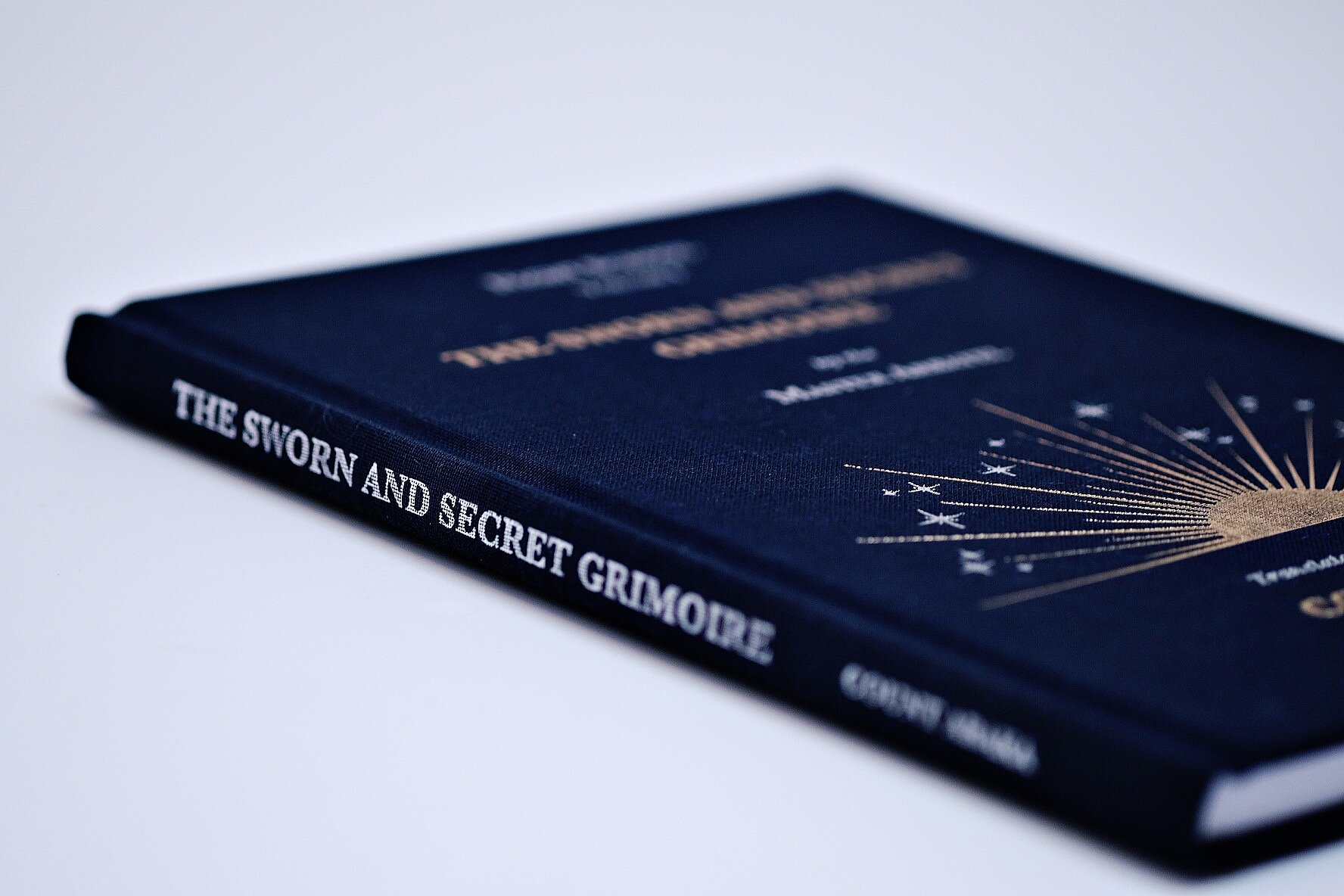‘The Sworn and Secret Grimoire’ by Jake Stratton-Kent
Review: Jake Stratton-Kent; The Sworn and Secret Grimoire – The Night School Vol I, by the Master Arbatel, translated for our age by Count Abaka, s.l.: Hadean Press, 2021, ISBN 978-1-914166-07-5 (hardcover), ISBN 978-1-914166-08-2 (paperback)
by Frater Acher
I. Genre Classification
To review Jake Stratton-Kent’s (JSK) most recent publication we first need to orientate ourselves with regards to the position it takes in the genre from which it emerges: grimoire magic.
In a nutshell, this genre saw a renewed proliferation into the Anglophone magical mainstream since the late 1990s. One of its most striking aspects is the tension between its inherently fluid and apocryphal nature, and the relentless desire of many of its modern authors to codify its occult history, ritual techniques and spirit hierarchies into a modern classical corpus. Amongst the publications that enabled this broad resurgence of the genre are Aaron Leitch’s Secrets of the Magickal Grimoires (Woodbury: Llewellyn Publications, 2005), Dr. Joseph C. Lisiewski’s Ceremonial Magic & The Power of Evocation (Los Angeles: New Falcon Publications, 2004) and Scarlet Imprint’s critical anthology Howlings (London: Scarlet Imprint, 2008).
Today, one of the most prominent authors of the genre is Dr. Stephen Skinner, notably in his work to excavate and re-codify the genre’s “classical techniques” (for detailed references see Skinner’s publications under his own imprint Golden Hoard). Therefore, to contextualise JSK’s most recent addition to the genre, it might be helpful to contrast its approach to Skinner’s work in particular.
One of the marked differences in approaches resides in the books’ differing purpose. Skinner’s work is distinctly shaped by his historic-exegetical methodology and orientated towards re-establishing a genre that is marked by historic authenticity, inherent coherence and sharply defined orthopraxy. In following mainly academic writing standards, Skinner’s catalogue of grimoire related publications, however, takes the greatest possible distance to actually explore what might best be called a magical phenomenology (see figure 1 at the end of this review). Reading his work, the audience is learning next to nothing about the actual first-hand experience of the myriad of gods, demons and angels on whose conjuration is exerted so much energy. The books are content to guide the reader through a maze of ritualistic design concepts and frameworks, and seem to have no interest in delving into the phenomenological sphere of what precisely happens to both humans and spirits once the circuit of ritual communion has been closed. In stark contrast to this, JSK’s purpose is precisely not one of historic authenticity, but one of subjectively experienced “efficacy” (p. 101).
The boldness in which JSK pursues this purpose is already evident in the choice of The Secret Grimoire of Turiel (Wellingborough: Aquarian Press, 1960) as the loose ritualistic framework of his book. Acknowledging on the first page of the Introduction this late source-work as an evident “forgery” (p.9) sets the mischievous tone for the rest of JSK’s elucidations.
To this reviewer, therefore, it is a very hope inspiring fact that JSK’s new book reveals early cracks of breaking free from the compulsory attention of the genre to ritual composition alone, and instead is unafraid to expand the reader’s horizon by sharing some first-hand experiences as a practitioner.
If one day this slender book was to be bound into another recent publication – as it was often the case with original grimoires in their manuscript forms – The Sworn and Secret Grimoire would sit much more comfortably alongside e.g. Frater U∴D∴’s (et al.) Living Magic (Woodbury: Llewellyn Publications, 2021), than say any of Skinner’s grimoire related works. JSK gently but decidedly brushes away the naive hope of offering the reader any sort of definite pathway, absolute truth or sanctified orthopraxy; instead, his book aims to create just about sufficient orientation points – as well as lazy readers’ trapdoors, one should add – so that each one of us can create, correct or continue to ruin their own ritualistic path.
Still, where both Skinner and JSK go hand in hand, is their conviction that in order to render grimoire-practice into a live modern tradition, what has to be avoided most of all is an “eclectic mishmash” (p. 104). Instead, what has to be pulled into visible foreground for each practitioner’s study through careful “ritual composition, reconstruction and analysis” (p. 101) are “coherence and ‘frames‘” (p. 104), in other words: “tactics and strategies framed on magical principles, rather than in accord with theological or political fashions” (p. 105).
II. Cut-Ups and Trapdoors
What is attractive about [The Secret Grimoire of] Turiel is its apparent simplicity, with a complete and comparatively easily executed process, and a semblance, at least, of a spirit hierarchy neither biblically angelic nor dangerously demonic. The presentation simply requires a different approach. So, this is not a ‘critical edition’ of Turiel or anything of the kind, nor is it an academic work. It is closer to a reforging of Hockley's well-conceived but problematic ‘forgery’, riffing on Turiel but drawing in other compatible material to fulfil potential neither version really does. (p. 9)
A simple overview of the Content of the book can be found on Hadean’s webpage. What we take from it on the fly is that the book comes in four essential sections: An Introduction, a “reforgery” of material taken from Turiel in combination with the Arbatel (Basel, 1575), Le Grand Albert (15th century), the Picatrix (11th century) and other sources, a dedicated section on planetary hours and timings, and finally two Appendices. If you asked this reviewer‘s opinion of the ratio of wisdom versus trapdoors in each of these sections, our answer would be 90% of the trapdoors were (deliberately?) inserted into the two middle sections, and 90% of the wonderful experiential wisdom this book has to offer is presented in the Introduction and the Appendices.
So let’s examine some of the trapdoors for starters. To find the first one we don’t need to look further than the initial line of the actual Sworn and Secret Grimoire.
Retire thyself Seven Days free from all company and fast and pray from sunset to sunrise. (p. 19)
Drawing on my own phenomenological experience of ritual magic, I’d happily confirm that if any practitioner can accomplish this simple sentence with integrity, the rest of the ritual is merely a periphery to this central act of re-centring oneself in the spiritual realm. At the same time this sentence is a trapdoor for any lazy reader, as they will easily brush it aside and replace it with seven days of lent, or they might even condense it into e.g. a single hour of meditation before they step into the magical circle.
The trick and the trapdoor lie in the seemingly simple request to “pray from sunset to sunrise” for seven consecutive days. To master this first step, is to turn this forgery of a grimoire into an actual book of spirit-practice. We will not elucidate further here on how to accomplish this, as it would violate the purpose with which JSK has put together and offered up this material.
The second example of a trapdoor to examine are the actual conjurations presented in the Sworn and Secret Grimoire. JSK decidedly presents his material as “a workbook for modern grimoirists, employing the all-but-lost but deeply-appropriate art of grimoire forging from actual grimoire materials” (p. 10). In this spirit, the author metaphorically puts us into the role of the half-human Caliban: We find ourselves stranded on an island of dead grimoires, salvaging our way through their remains towards our own praxis; driven by the hungry idea of regaining coherence and wholeness of our spiritual path, as represented by the character of the archmage Prospero. On this narrative journey, the main criteria for leveraging or dismissing grimoire debris are explicitly called out by JSK: It’s the notion of picking up “useable ritual material” (p. 14), in order to restore a “complete and comparatively easily executed process” (p. 9) while carefully avoiding the trapdoor of “crazy magicians whose tables ignore distinctions like different systems” (p. 12). Beyond that general approach, JSK’s particular motivation for the selected material he presents “was to provide a grimoire for working with Olympic Spirits, restoring the link with non-Solomonic strands of the grimoires” (p. 13).
The Paracelsian phase of grimoire production remains Christian of course, however the ‘old gods’ are essentially rehabilitated in the form of ‘Olympic Spirits’. So too various other rapprochements are made with earlier lore (see the Arbatel) which are not a feature of Solomonic works, which tend to demonise pagan forms. There are other ways in which Paracelsian magical thought – including its understanding of the spirits and their spheres of operation – differs massively from more familiar ‘Qabalism’ and Solomonic alike. Considerations such as these however would take us too far from the objects of this supposed 'beginners' manual. One might add that no real occult primer has ever really started at the ‘shallow end’ anyway, but it is traditional to make and maintain the pretence. (p. 16)
When examining the actual conjurations given, we realise that we are still confronted with an unmistakable degree maybe not of “eclectic” but certainly incomprehensible “mishmash”. Unlike in the Arbatel, which is purely Christian-Paracelsian in its style, in The Sworn and Secret Grimoire we also find a strong Christian framework filled in with either Classical Greek god-names or the Olympic Spirits (depending on the practitioner’s choice). However, this core still appears surrounded by much draping of divine and barbaric names (e.g. p. 54), as well as the invocation of Christian lineages of “Saints, Martyrs, Innocents” (p. 57).
From a phenomenological perspective of creating a magical process with high efficacy, we see it leaning against the spirit of this book to leverage any names that either lack clarity of who/what they are designating, or which lack collective coherence as being unable to be integrated into a single cosmological system. Let’s be clear: Solomonic Magic never aspired to a level of inner coherence and transparency anywhere close to what JSK is venturing for, which is precisely why the author is suggesting to work around Solomonic Magic.
But herein lies the author’s trick: JSK’s form of presenting, not only the conjurations themselves, but the entire ritual process as a kind of cut-up art from various sources and backgrounds, can easily ward off the above criticism. What could be read as inconsistencies are in fact fracture lines of the grimoire debris assembled into this new “reforgery”. Therefore, the remaining incongruities should be understood not as a bug but as a feature. Here we encounter another of the above-mentioned trapdoors: JSK’s Sworn and Secret Grimoire is not at all a ready-made modern grimoire. Instead, it challenges its reader in similar ways like the cryptic composition and language of the Arbatel has been challenging readers for more than four centuries: points where meaning-making is breaking off, where one’s understanding – like the Tarot’s fool – walks out over the edge into Otherness, are not at all flaws of the newly arranged text, but an explicit invitation to reforge the material into each practitioner’s own practice.
III. Awesome Appendices
This in order to show that ‘modernism’ and ‘classicism’ are not necessarily airtight compartments, and thus to widen the field of discourse while simultaneously keeping it focused. (p. 88)
To all of us Calibans, aspiring to channel some of our raw ritual uncivility into the sophistication of a Prospero, if we only had an hour to spend with The Sworn and Secret Grimoire, I’d strongly recommend to begin by reading its appendices.
One could assert that JSK’s voice has the most impact and rings the truest, not when he is merely presenting reforged historic material, but when he is taking it into the periphery of his own lived magical experience, and allows the latter to take centre stage.
In Appendix I. The Sixfold Process of Evocation: Modern and Classical on less than twenty pages JSK presents more condensed insights and efficacy than we might find in entire books on the subject elsewhere. That is because our author knows how to speak about conceptual frameworks from a lens of decades of first-hand experience. He is courageous enough to transcend borders of time and culture in the sources he chooses from – neither painting the past as a golden age, nor elevating more recent practitioners such as Aleister Crowley to the status of orthodox gurus. Instead, he underpins each choice he makes with a clear rationale, allowing the reader not only to follow his thought process in reassembling ritual integrity from the debris of dead grimoires, but actually acting as a role model in helping readers to develop this precise skill themselves.
In light of this, the particular feedback this reviewer would love to share with publisher and author is the following: one could have made the bold decision to condense both middle chapters of this book into a few succinct lines of working instructions to aspiring „grimoirists“. It could have read somewhat like this: “Dear Calibans, walk over to this shipwreck of a grimoire and plunder for invocations, then stroll over to this one and grab its knowledge on planetary timings, then take the Olympic Spirits from the Arbatel, etc.” This would have elevated the readers’ awareness of the hands-on work expected from each of them in order to reforge their own version of a living grimoire, and thus reduced one big trapdoor of misreading the present text as a grimoire-to-go. Much more importantly, it would have freed significant time on the author’s side to tell us more about his lived experience with the spirits he is encouraging us to work with.
We strongly hope that future volumes in the “Night Series” are due soon. We also hope that they will show even more appetite to deviate from the well-worn path of obsessing over ritual architecture and design. Instead, we could think of very few authors of similar capability, skill and experience to forge a new path into the largely untrodden territory of magical phenomenology - and to share unique stories of his dwelling and living with the spirits everyday. As secondary and uneventful as some of these anecdotes and stories from his own biography might seem to JSK, they are what will inspire future practitioners to find their own path, even more so than ritual process flowcharts. JSK has made a bold beginning by introducing us to his ancestral ghost called Jack. We hope both Jack and Jake will continue to share their personal stories with us – of what happened in one the most fascinating contemporary magician’s life once the ritual circuit had been closed.
figure 1: A sketch of the four main phases of a ritual cycle. Magical Phenomenology in such a context should be understood as the stage of both the ritual performance as well as the critical subsequent phase of inhabiting the reality co-created with the respective spirits of one’s work. Traditionally, especially in the grimoire genre, a more careful description and attention to this experiential phase of one’s magical work has been left out.








